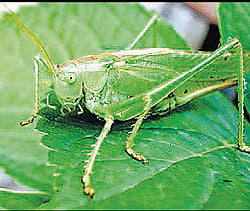Scientists have recreated what they claim is the world's most ancient known music -- the crooning of a prehistoric cricket, thanks to a fossil found in China.

An international team, led by Bristol University, has used the exquisitely preserved, fossilised remains of the extinct Jurassic bush cricket, which lived 165 million years ago, to recreate its chirp.
The song, possibly documented to date, was reconstructed from microscopic wing features on a fossil of the cricket -- Archaboilus musicus -- discovered in North East China, say the scientists behind the work.
"This is one of the oldest mating calls ever reconstructed from a fossil," Fernando Montealegre Zapata, who led the team, was quoted by 'The Guardian' as saying.
In its research, the team examined the anatomical construction of the fossil's song apparatus, and compared it to 59 living bushcricket species. They concluded this insect must've produced musical songs, broadcasting pure frequencies.
"This discovery indicates that pure tone communication was already exploited by animals in the middle Jurassic 165 million years ago. For Archaboilus, as for living bushcricket species, singing constitutes key component of mate attraction.
"Singing loud and clear advertises the presence, location and quality of the singer, a message that females choose to respond to or not. Using a single tone, the male's call carries further and better, and therefore is likely to serenade more females.
"However, it also makes the male more conspicuous to predators if they have also evolved ears to eavesdrop on these mating calls," team member Prof Daniel Robert was quoted by the 'Daily Mail' as saying.
The findings have been published in the 'PNAS' journal.